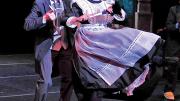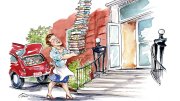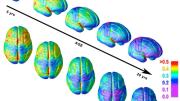When Primus was a little one, he had the good fortune to live near Broadway in Manhattan. Each holiday season, his parents would take the family to the Great White Way to see the latest magical musical, South Pacific perhaps, or Guys and Dolls. Then we would stroll over to the Harvard Club of New York on 44th Street and sit by the fire in the paneled richness of the place. Even the youngest among us was permitted a glass of unexpurgated eggnog, served by a tipsy waiter. These moments live in memory.
When the time came and Primus moved to Cambridge, he searched for similar entertainments for his family in the Boston so-called theatre district, but all he found during Christmas week was precious little. Years later, it’s mostly the unstoppable Blue Man Group and The Nutcracker.
Mrs. Primus had a niece who lived near Hartford, Connecticut, and as soon as the girl learned to walk, she began to dance in The Nutcracker with the Hartford Ballet. She danced it year after year after year, and went on to dance it (and other things) professionally with the Nashville Ballet. During this dear girl’s childhood, it was necessary to watch her dance in The Nutcracker. By the time she was grown, Primus had seen the ballet 782 times. What he would have given for some Guys and Dolls.
Of course, The Nutcracker is the salvation of many ballet companies in America, a crucial part of their economic equations. Jennifer Fisher, a former snowflake and flower, and now associate professor of dance at the University of California, Irvine, has written a book about the ballet, Nutcracker Nation: How an Old World Ballet Became a Christmas Tradition in the New World. She notes that after the ballet immigrated to the United States in the mid-twentieth century and was choreographed by George Balanchine, it began to thrive and variegate. Hawaiians added hula, Canadians added hockey, and so on.
Primus strives not to take a dark view of this beloved ballet. Neither does Henry D. Rogers ’54, of Jacksonville, Florida. He wrote to report that he had been named Florida Land Realtor of the Year 2014, not only for sales production but also for dancing in The Nutcracker for the past 35 years.
“The 175 or so of us in the production, accompanied by the Jacksonville Symphony Orchestra, are volunteers except two national leads,” he explains. “My first time in Nutcracker was in 1977, when my daughter, Katherine, had charge of rehearsing the Party Scene, first act. Three weeks before it was going on stage, she said, ‘Dad, I have to have one more man on stage and you are it,’ knowing that with my ballroom ability it could work out. The first rehearsal I went to, a gorgeous sweet blonde came up to me and said, ‘I am your partner.’ (Where in the hell had I been and why not here? was my thought...) For many years, I was one of the adults in the Party Scene, once as Herr Drosselmeier, a few times as a butler, and for the past 15 years or so as Grandfather. It has been my main volunteer contribution to the city for many years and good for my business.”
* * *
Primus cannot stop talking about himself, apparently. At 5:27 p.m. on November 9, 1965, he was sitting with his spouse, cross-legged, on the naked floor of a house they had just bought in Cambridge near the Common, a thing normal people can no longer do. They were with friends, lifting a celebratory glass of something when the lights went out. The entire northeast of the United States and large parts of Canada went dark, creating much mischief and some disaster. That evening 80,000 square miles of habitat were without power, leaving 30 million people in persistent dark. Yours truly scoffed at the darkness. He believed, then as now, that he lived in a citadel of enlightenment.









